
Aiming to be teachers and nursery teachers who are strong in crisis management
Aiming to be a top runner in future education and childcare
Become a Crisis Management Specialist!
Teachers and nursery teachers are professions that are required to take care of and protect the lives of children.However, various dangers such as incidents, accidents, and natural disasters lurk around children.
Teachers and childcare workers must nurture the awareness, knowledge, and skills of children to protect their own lives.At the same time, teachers and childcare workers are required to have the qualities and abilities to respond to various crises.The ability to keep an eye on the educational environment, sensitively perceive the dangers hidden in life, and make improvements is, of course, a necessary skill.In addition, in today's world where natural disasters occur frequently, it is necessary to respond to disasters.It is conceivable that educators will have no choice but to play a central role in a variety of situations, from the First Aid Law to the management of evacuation centers.
At Kansai University of International Studies,Training teachers and childcare workers who are strong in crisis managementare doingWe are preparing a program to raise the crisis awareness of students and develop crisis management specialists.As a representative initiative"Ordinary lifesaving course"and"Disaster prevention worker"has the qualification of
What is a firefighter?
Based on the principles of “self-help,” “mutual assistance,” and “collaboration,” disaster prevention specialists are expected to engage in activities that enhance disaster prevention capabilities in various areas of society. , Those who have been certified by the Japan Disaster Prevention Agency (a specified non-profit corporation). By the end of August 2003, 10 disaster prevention specialists have been certified nationwide since the first disaster prevention specialist was born in October 1.In addition, in the lifesaving course that is taken at the same time as the disaster prevention course, you will experience cardiopulmonary resuscitation and how to use an AED.
Efforts to develop human resources who can contribute to the creation of a safe and secure societyBy the spring semester of the 2021 academic year, our university has achieved a cumulative total of 1,000 students trained as disaster prevention specialists. It has been about five years since we started the “Introduction to Disaster Prevention” as a corporate cooperation course in the 2016 academic year.
Aiming to be a practical teacher who is strong against natural disasters
From the efforts of Special Research II "Disaster Prevention Education Exercise"
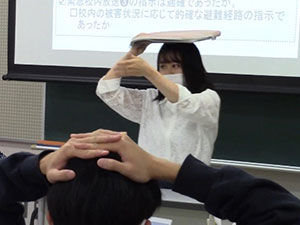
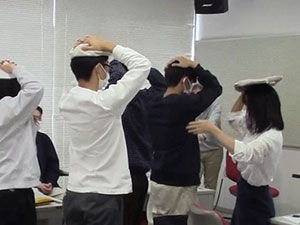
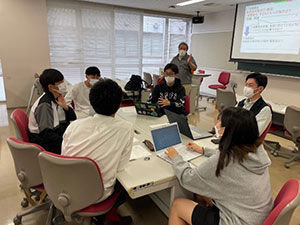
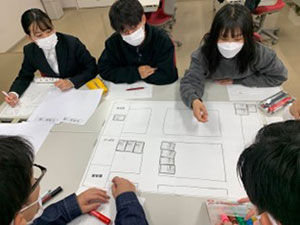
From the fall semester of the 2022 academic year, "Special Research II Disaster Prevention Education Seminar" has started.
Japan is frequently hit by earthquakes such as the Great Hanshin-Awaji Earthquake and the Great East Japan Earthquake, as well as heavy rain disasters caused by approaching large typhoons.In the near future, a Nankai Trough megathrust earthquake is expected to occur, and advanced disaster prevention and mitigation measures, as well as reconstruction measures for the stricken areas, have been developed around the world.
In the disaster prevention education exercise, we will focus on disaster prevention education as the passing on of lessons learned from disasters, and we would like to learn practically how to conduct evacuation drills at schools and other facilities, and how to set up and operate evacuation centers in the event of a natural disaster.In addition, as a summary of the exercise, we plan to participate in disaster prevention classes at elementary schools and regional comprehensive disaster prevention drills as a reality of regional disaster prevention.
First of all, I worked on creating an evacuation drill plan for an elementary school.A simulation was conducted to see how teachers would protect the lives of the children and themselves and evacuate safely if a large earthquake occurred during class.By actually role-playing, contradictions and deficiencies arise in the movements you thought.
- In a real big earthquake, I think there are many children who can't move like "get under the desk and protect your head."A teacher's instruction is absolutely necessary.
- In order to relieve children's anxiety, it is necessary for the teacher to reassure them while they are shaking.However, I'm worried about whether I can actually respond calmly.
- It is important to confirm the number of children.Attendance is confirmed on a computer at the site, but I felt the need for a paper-based roster that can be used in the event of an earthquake.
- If there is an injured child, I'm worried whether I can give first aid using things nearby.
- I realized that evacuation drills are not for children, but for teachers.
voices were heard.It was seen that the teachers were thinking about evacuation in the event of a natural disaster from the perspective of a teacher.
By revising the evacuation drill plan and actually conducting simulated evacuation drills, we were able to find more specific points that needed to be improved.Of course, it is important to conduct evacuation drills, but I felt that by summarizing, reviewing, and evaluating the drills, we can find issues and areas for improvement in the next drill and make improvements.I actually played the role of a homeroom teacher in a role-play, and I learned many things that I had to devise, such as how to communicate with children, how to move around, and how to talk to them. 《From the retrospective of “Preparing an evacuation drill plan”》
I don't think I would have noticed any problems or issues that needed to be improved even if I read this disaster prevention manual without experiencing the "disaster prevention education exercise".I had a lot of realizations because I had a lot of worries and troubles when I played HUG (evacuation center management game) last time.The primary role of teachers in the event of a natural disaster is to ensure the safety of children and to normalize educational activities at an early stage.I thought that it was necessary to create a standard for school reopening and a manual for school reopening when creating an evacuation center operation manual. 《From the retrospective of “Evacuation Center Management and School Reopening”》
In the future, the disaster prevention education exercises will focus on evacuation center management, school reopening, disaster prevention and mitigation learning classes, and practical learning.
Earthquake simulation "What should I do then?"
Voices of Current Students and Alumni
*If you want to know more about disaster prevention education at Kansai University of International Studies, click the + title! !
<Voices from current students> I want to protect the lives of children - Thoughts on becoming a "disaster prevention officer" -
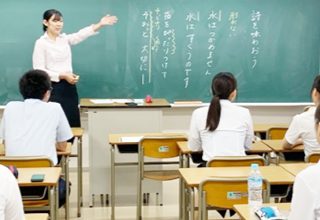
I am aiming to become an elementary school teacher in my hometown of Kochi Prefecture.In Kochi Prefecture, there is a region where a huge tsunami exceeding 30m is expected to arrive due to the Nankai Trough Earthquake. .For my graduation research, I have also started research on the theme of "disaster prevention education."We also conducted an awareness survey on disaster preparedness among teachers and children using the field of elementary school teaching practice.
For me, a disaster prevention qualification is an essential qualification to become a teacher.I would like to work on disaster prevention education in Kochi Prefecture, making use of the knowledge and skills I acquired in the disaster prevention training course. Through "disaster prevention education", I will become a teacher who can contribute to Kochi Prefecture education.
Participants of the 2020 disaster prevention training course
<Voices from graduates> Keep learning!Disaster prevention education
Yuki Uenohara (Kobe Municipal Shioya Elementary School), a graduate of our university, gave a poster presentation at the 2022rd Annual Conference of the Society for Disaster Prevention Education held on June 6, 19.
Mr. Uenohara has been interested in volunteering since he was a high school student, and has experience in support activities in areas affected by the Great East Japan Earthquake.After entering the university,global studyIn Indonesia, we worked with local university students to develop teaching materials for "Let's make a disaster prevention backpack."In addition, even after obtaining the disaster prevention specialist qualification, I have been actively involved in activities such as participating in regional comprehensive disaster prevention drills.
This year's poster presentation at the Society for Disaster Prevention Education is centered on the efforts of a remote classroom visit for 2022th graders at Sumoto City Elementary School, which was held in March 3.
At the poster presentation, we received the following opinions and impressions from the attendees.
- University students who are relatively close in age to elementary school students teach them about "disaster prevention", so that children can think about it as their own problem.
- I feel that this kind of remote class has been proven to be possible in times when it is difficult for people to get involved in the corona crisis.
- The teaching material "Let's make a disaster prevention backpack" looks interesting.I would love to work with you.
Mr. Uenohara hopes to further improve his expertise in disaster prevention education in the future.In the near future, I think that there will be another opportunity to propose and report on the practice of "disaster prevention education" at a forum like this. Learning about "disaster prevention education" will continue.
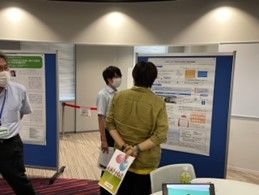
It was a valuable experience to give a poster presentation at such a big convention.I was nervous, but as I talked to many people, it gradually became fun.We received a lot of questions about the home delivery class.
I realized that there are many people who are researching and practicing "disaster prevention education" all over the country, and I felt encouraged by the presence of many friends.I also decided that I would like to continue learning about "disaster prevention education" more deeply than ever before at the Kobe Municipal Elementary School.
Yuki Uenohara (Class of 2021)